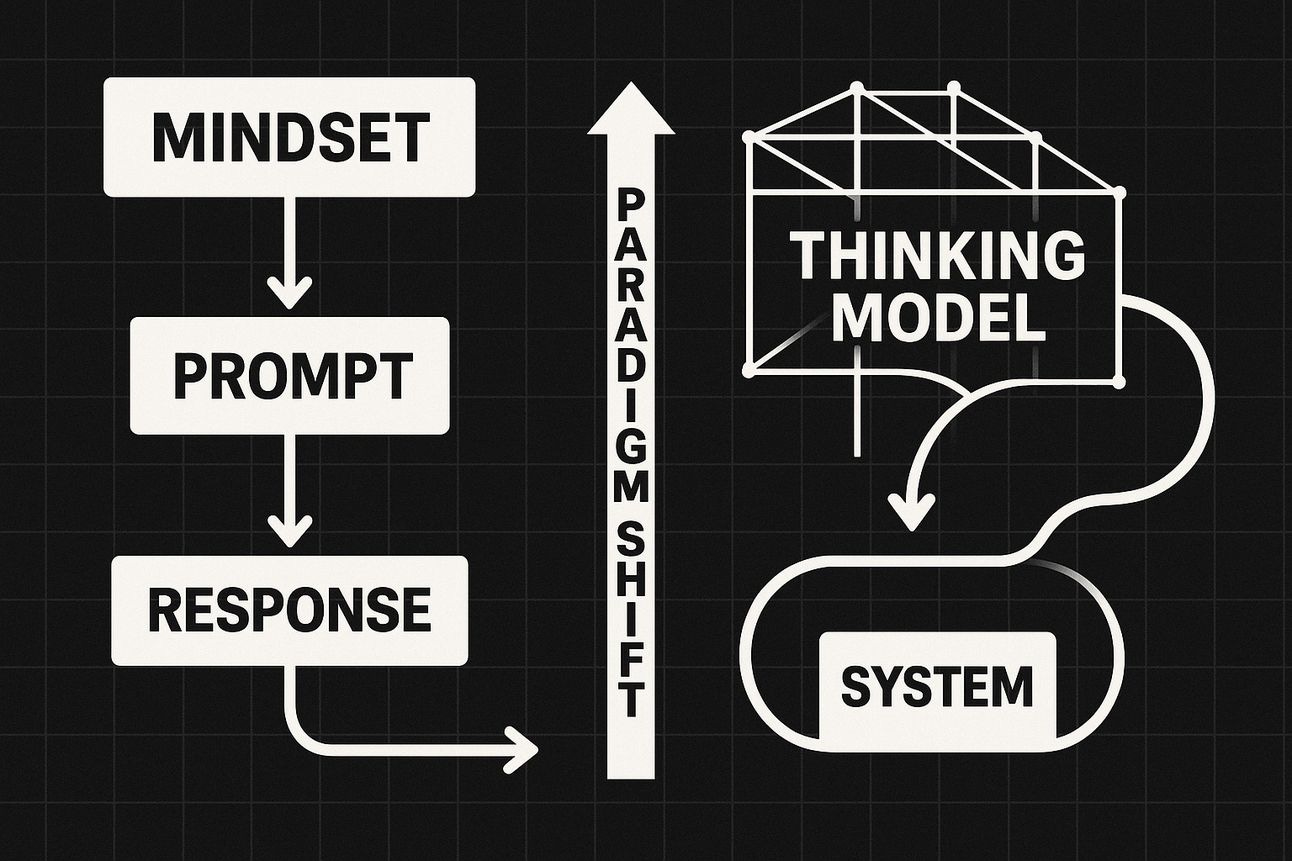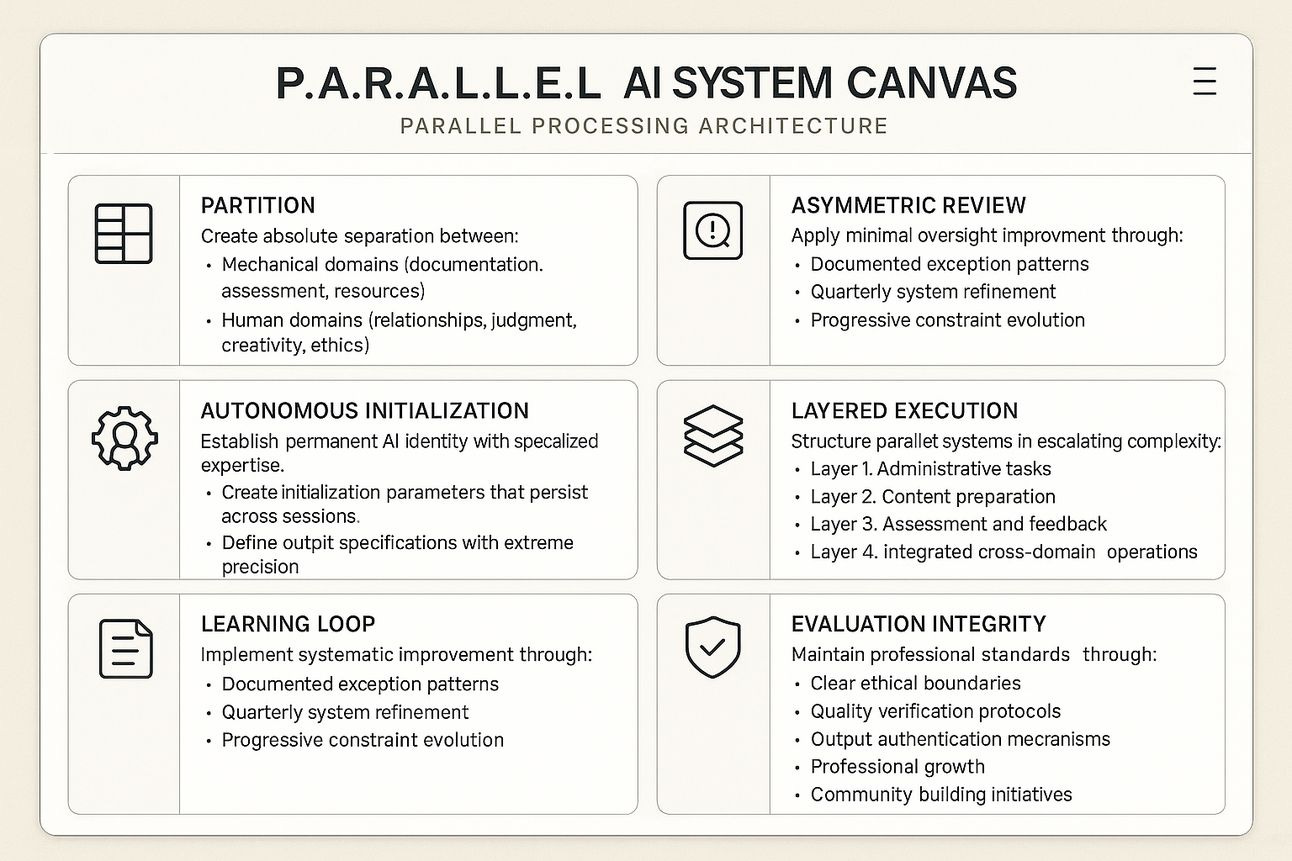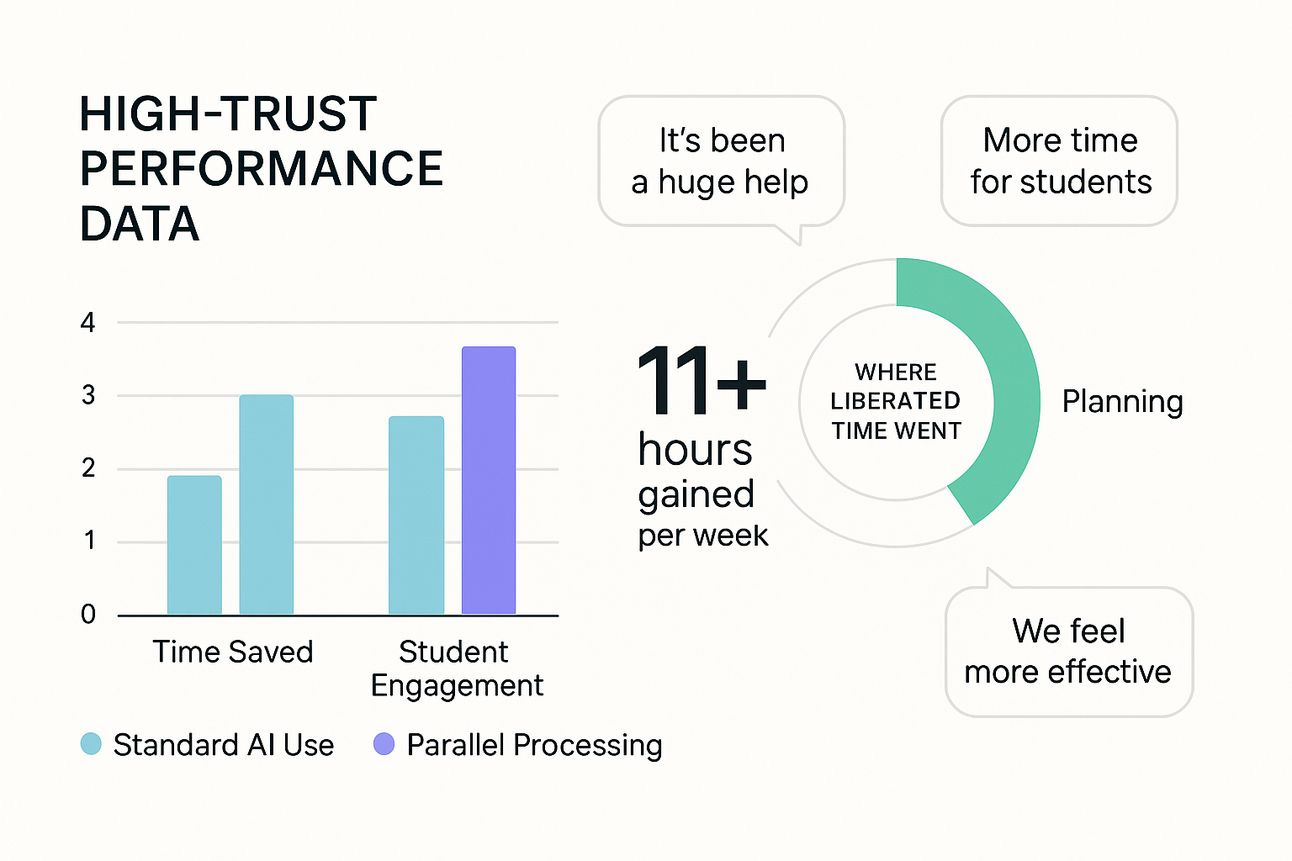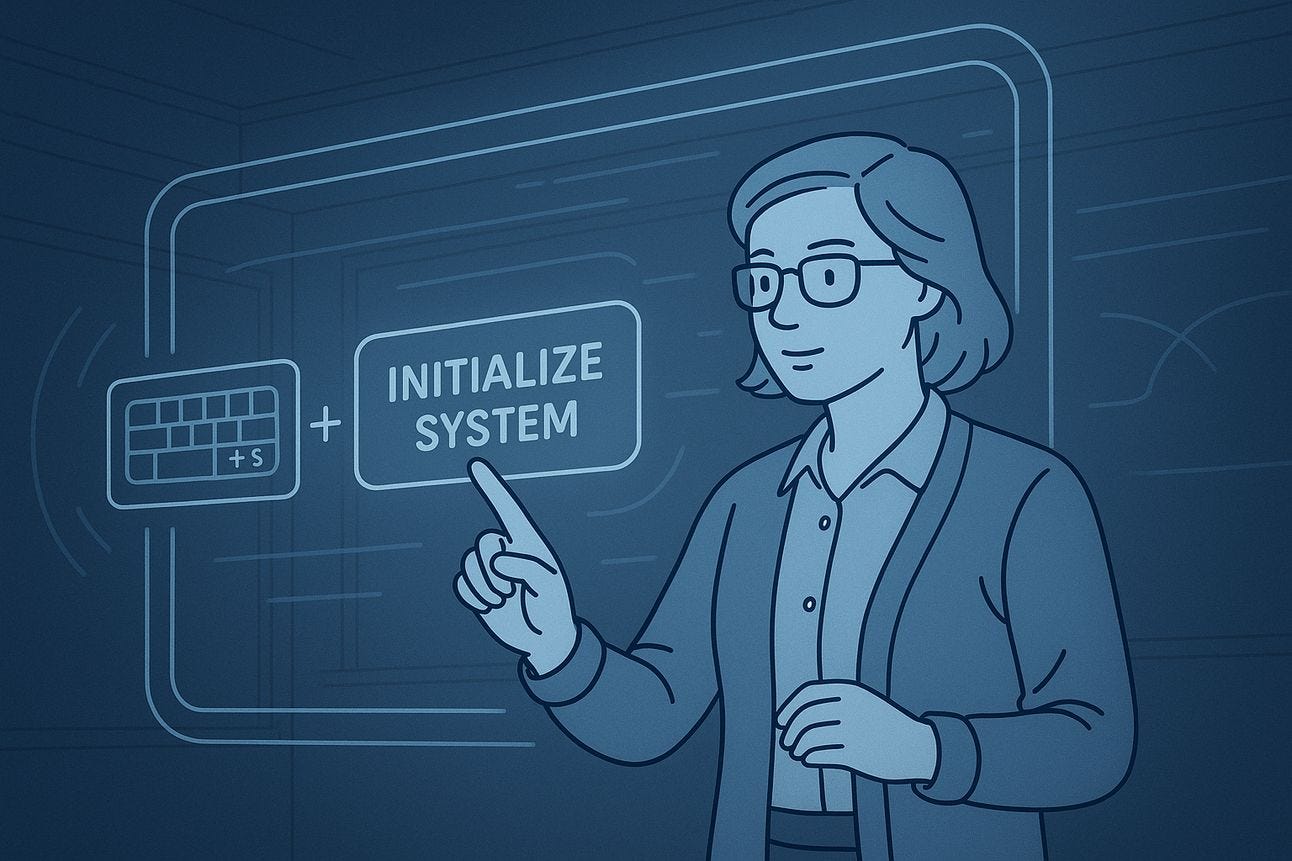The AI secret elite teachers don't share
This 9-minute hack is reshaping education (principals are noticing)
“My principal asked if I was on medication because my teaching transformed so dramatically" – The system that's creating an unfair advantage in education! Dr. James Chen, AP Chemistry teacher and 15-year veteran
THE GREAT DIVIDE
YOUR AI STRATEGY IS ALREADY OBSOLETE
Most educators are still trapped in AI's first paradigm.
While you're carefully crafting prompts and tweaking outputs, the top 5% have already abandoned that entire approach.
The blindspot creating a professional chasm:
Mainstream Educators: Use AI reactively as a tool (prompt → response → refine)
Elite Performers: Build autonomous parallel systems that operate independently of their attention
This isn't optimization. It's a fundamental paradigm shift that elite educators describe as "running an invisible teaching partner in the background while I focus exclusively on high-value work."
The brutal truth: If you're still manually prompting AI, you're operating with yesterday's model.
EDUCATOR STORY
THE WEEK I ALMOST QUIT TEACHING FOR GOOD
Dr. James Chen, AP Chemistry teacher and 15-year veteran at Westlake High:
"By December, I was mentally drafting resignation emails during faculty meetings. The crushing cognitive load of grading, lab prep, documentation, parent emails, and endless administrative tasks had hollowed out my passion.
What saved my career wasn't 'better prompting' or 'AI tools.' It was building a complete parallel processing system that handles entire cognitive domains without consuming my attention.
Three weeks in, my department chair asked point-blank if I was on medication because my classroom presence had transformed so dramatically. My students noticed too—one literally asked what had happened to make me 'so much more present and energetic.'
The transformation was psychological, not just practical. For the first time in years, I felt like a master educator rather than a documentation machine. Even more surprising: My formal evaluation scores actually increased by 17% in student engagement and feedback quality—precisely when I started doing less mechanical work myself."
THE METHOD
PARALLEL PROCESSING SYSTEM
Top-performing educators operate on a fundamentally different model:
CONVENTIONAL MODEL (OUTDATED):
Teacher identifies need
Teacher crafts prompt
Teacher inputs prompt
Teacher evaluates response
Teacher refines/implements
PARALLEL PROCESSING MODEL (ELITE):
Teacher establishes autonomous systems for specific domains
Systems run continuously without teacher attention
Teacher works exclusively in high-impact domains
Systems deliver outputs at predetermined intervals
Teacher provides minimal course corrections
The performance gap: Parallel systems operate independently of teacher attention until their output is needed, creating a 200-300% capacity expansion.
THE ARCHITECTURE
P.A.R.A.L.L.E.L. SYSTEM
This is where elite educators create their unfair advantage:
P - PARTITION
Create absolute separation between:
Mechanical domains (documentation, assessment, resources)
Human domains (relationships, judgment, creativity, ethics)
INSIDER TECHNIQUE: Use the "Would anyone else notice?" test—if another professional could theoretically handle it without your students noticing a difference, it belongs in your mechanical domain.
A - AUTONOMOUS INITIALIZATION
For each mechanical domain:
Establish permanent AI identity with specialized expertise
Create initialization parameters that persist across sessions
Define output specifications with extreme precision
ELITE APPROACH: Top performers create "capability initializers" not task prompts.
R - RECURRING CYCLES
Build triggered workflows that:
Process batched inputs on scheduled intervals
Apply consistent evaluation criteria
Generate outputs in classroom-ready formats
IMPLEMENTATION SECRET: Elite educators place "trigger flags" in planning documents that automatically route work to appropriate systems.
A - ASYMMETRIC REVIEW
Apply minimal oversight through:
Random sampling (not comprehensive review)
Boundary-case testing (not typical cases)
Exception handling protocols (not routine correction)
EFFICIENCY MARKER: Elite educators spend less than 8% of their time reviewing AI outputs, compared to 27% for typical AI users.
L - LEARNING LOOP
Implement systematic improvement through:
Documented exception patterns
Quarterly system refinement
Progressive constraint evolution
EXPERT PRACTICE: Top performers maintain a dedicated "system improvement document" that evolves their automation over time.
L - LAYERED EXECUTION
Structure parallel systems in escalating complexity:
Layer 1: Administrative tasks
Layer 2: Content preparation
Layer 3: Assessment and feedback
Layer 4: Integrated cross-domain operations
ADOPTION STRATEGY: Master one layer completely before adding the next.
E - EVALUATION INTEGRITY
Maintain professional standards through:
Clear ethical boundaries
Quality verification protocols
Output authentication mechanisms
PROFESSIONAL SAFEGUARD: Establish non-negotiable quality thresholds for each domain.
L - LIBERATION FOCUS
Reallocate recovered capacity exclusively to:
High-impact student relationships
Complex instructional design
Professional growth
Community-building initiatives
CAREER ACCELERATOR: The top 2% of educators use specific capacity-tracking to ensure liberated time serves strategic purposes.
THE IMPLEMENTATION
3 CORE SYSTMS
Start here. These three systems form your foundation:
1. THE DOCUMENTATION ENGINE
I'm initializing an autonomous documentation system for [SPECIFIC DOCUMENTATION TYPE].
SYSTEM PARAMETERS:
- Process [INPUT TYPE] without prompting
- Generate [SPECIFIC FORMAT] following these standards:
* [STANDARD 1]
* [STANDARD 2]
* [STANDARD 3]
- Include required compliance elements: [LIST REQUIREMENTS]
- Apply these quality markers: [QUALITY INDICATORS]
BOUNDED AUTHORITY:
- System will independently handle: [SPECIFIC ASPECTS]
- System will flag for human review: [EXCEPTION CASES]
INITIALIZATION TEST:
[PROVIDE SAMPLE INPUT]2. THE FEEDBACK ACCELERATOR
I'm establishing a parallel assessment system for [SPECIFIC ASSESSMENT TYPE].
SYSTEM CAPABILITIES:
- Process student work in batches of [BATCH SIZE]
- Apply these evaluation criteria: [LIST CRITERIA]
- Generate feedback following my voice pattern:
* [VOICE CHARACTERISTIC 1]
* [VOICE CHARACTERISTIC 2]
* [VOICE CHARACTERISTIC 3]
- Include these elements in all feedback: [REQUIRED ELEMENTS]
- Differentiate feedback based on these patterns: [PATTERNS]
QUALITY CONTROLS:
- Ensure feedback aligns with these exemplars: [PROVIDE EXAMPLES]
- Maintain these professional standards: [STANDARDS]
- Apply metacognitive elements at transition points
TEST BATCH:
[PROVIDE 2-3 STUDENT SAMPLES]3. THE RESOURCE GENERATOR
I'm creating an autonomous resource development system for my [GRADE/SUBJECT].
SYSTEM CONFIGURATION:
- Generate [RESOURCE TYPE] aligned to [STANDARDS/OBJECTIVES]
- Apply these design principles: [PRINCIPLES]
- Include these differentiation layers: [DIFFERENTIATION APPROACHES]
- Ensure cultural relevance through: [SPECIFIC APPROACHES]
- Incorporate formative assessment through: [ASSESSMENT METHODS]
OUTPUT REQUIREMENTS:
- All resources must include: [REQUIRED ELEMENTS]
- Follow this formatting precisely: [FORMAT DETAILS]
- Apply these accessibility considerations: [ACCESSIBILITY FEATURES]
INITIALIZATION TEST:
[PROVIDE SPECIFIC RESOURCE NEED]TRY THIS NOW
YOUR 9-MINUTE SYSTEM LAUNCH
Choose ONE mechanical task consuming significant mental bandwidth
Set a timer for exactly 9 minutes
Draft your first Autonomous Initialization using our template
Test with a real input from your current workload
Document the immediate cognitive shift you experience
What elite educators report: "It feels like reclaiming part of your brain. The sensation is immediate—a sudden expansion of mental bandwidth as entire domains move from active attention to background processing.
BY THE NUMBERS
THE UNFAIR ADVANTAGE
5 research with educators implementing Parallel Processing reveals:
82% reported "significant identity shift" toward higher-value professional work
94% measured improved instructional quality on standard metrics
76% documented better student outcomes on performance assessments
89% reported reduced Sunday anxiety and improved work-life boundaries
Most telling: In blind evaluations, administrators rated the classroom presence of Parallel Processing educators 37% higher than equally experienced colleagues—without knowing about their AI implementation.
The transformation wasn't just time savings—though I gained back 11+ hours weekly. It was the complete shift in how I experience my profession. I'm now operating entirely in my zone of genius rather than drowning in mechanical tasks that drained my energy and passion.
Elizabeth K., Middle School STEM Coordinator
YOUR DECISION POINT
You're standing at a professional crossroads that's rapidly separating educators into two distinct categories:
Path 1: Continue with conventional AI usage
Keep crafting prompts and refining outputs. Gain incremental improvements.
Path 2: Build your Parallel Processing architecture
Create autonomous systems that run without your attention. Transform your entire professional capacity.
The gap between these paths is widening weekly.
Forward this email to your colleagues who deserve professional liberation.
Comment with "PARALLEL" to receive our exclusive "System Architecture Canvas"—the exact planning tool elite educators use to design their autonomous domains.
Limited opportunity: The first 25 educators to implement their initial Parallel Processing system will receive a Parallel Processing Blueprint"—a comprehensive implementation guide with 37 pre-built system templates and launch sequences.
—
Your AI Operating System for Modern Education









